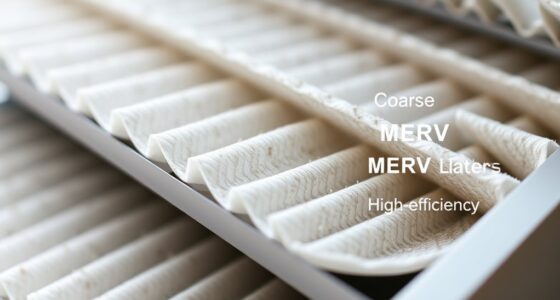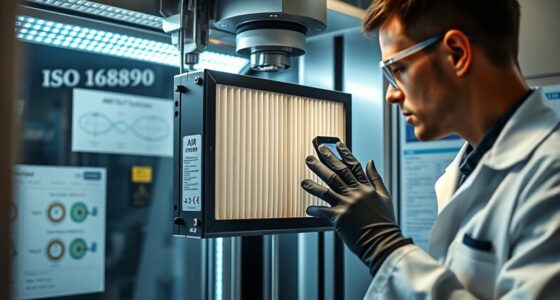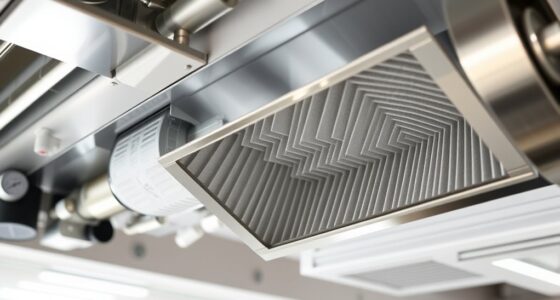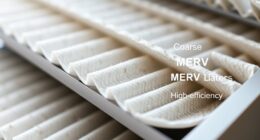ISO 29463 and EN 1822 set rigorous testing standards for HEPA and ULPA filters, ensuring they meet high safety and efficiency levels. These standards specify procedures for measuring particle penetration, especially for 0.3-micron particles, and categorize filters by their performance class. Proper testing and certification help you confirm filter reliability and compliance with safety regulations. Continuing this exploration will provide you with a deeper understanding of how these standards guarantee filter quality.
Key Takeaways
- ISO 29463 and EN 1822 set standardized testing methods for HEPA and ULPA filters’ efficiency and performance.
- Both standards use aerosol penetration tests with 0.3-micron particles to evaluate filter effectiveness.
- ISO 29463 classifies filters based on penetration and efficiency levels, ensuring regulatory compliance.
- EN 1822 assesses filter properties through aerosol penetration, categorizing filters like H13 and H14.
- Proper calibration and testing procedures are essential for certification and verifying filter performance per these standards.

Testing HEPA and ULPA filters is essential to guarantee they meet strict standards for air purity and safety. As someone responsible for ensuring clean environments, you need to understand how filter efficiency plays a critical role in achieving this goal. Filter efficiency measures how effectively a filter removes particles from the air, and rigorous testing standards are in place to verify this performance. These standards, such as ISO 29463 and EN 1822, set the benchmark for determining whether a filter can be trusted in sensitive settings like hospitals, laboratories, or cleanrooms.
ISO 29463 is an international standard that specifies the classification, testing, and validation of high-efficiency particulate air (HEPA) and ultra-low particulate air (ULPA) filters. When testing filters against ISO 29463, you focus on parameters like penetration and efficiency. Penetration indicates how many particles pass through the filter, while efficiency shows the percentage of particles captured. To meet the standard, filters must demonstrate specific efficiency levels for various particle sizes, typically 0.3 microns, as these are the most penetrating particles. This testing process ensures that the filter’s performance aligns with the required safety and purity levels, giving you confidence in its reliability.
ISO 29463 certifies HEPA and ULPA filters by testing penetration and efficiency for 0.3-micron particles.
EN 1822, another widely recognized testing standard, emphasizes the physical and functional properties of HEPA and ULPA filters. It introduces a rigorous testing method known as the aerosol penetration test, where an aerosol of standardized particles is drawn through the filter under controlled conditions. The filter’s efficiency is then calculated based on the number of particles that pass through. EN 1822 also categorizes filters into different classes, like H13 or H14, indicating their level of filtration performance. By adhering to EN 1822 testing protocols, you ensure that the filters you select are certified to meet stringent performance criteria, reducing risks associated with airborne contaminants.
Both these standards demand precise testing procedures and calibration to ensure consistency. When evaluating filters, you must verify that they have undergone these tests and received certification. This process not only confirms the filter’s efficiency but also helps in maintaining regulatory compliance. If you’re responsible for selecting or certifying filters, understanding these testing standards allows you to make informed decisions that prioritize air quality and safety. Ultimately, rigorous testing according to ISO 29463 and EN 1822 guarantees that your filters perform as expected, safeguarding the environment and the health of those who rely on it.
Additionally, proper calibration of testing equipment is crucial to obtaining accurate and reliable results in accordance with these standards.
Frequently Asked Questions
How Often Should HEPA and ULPA Filters Be Tested?
You should test HEPA and ULPA filters regularly, typically every 6 to 12 months, to guarantee maximum filter lifespan and performance. Testing intervals depend on your usage environment, filter age, and manufacturer recommendations. Performing these tests consistently helps identify any decrease in filtration efficiency early, preventing potential contamination issues. Keep a maintenance schedule and track results to maintain a safe and effective filtration system.
What Are Common Signs of Filter Failure?
You’ll notice your filter’s health fading like a dying star when contamination indicators appear or airflow drops. These signs signal the filter’s lifespan is nearing its end, and failure may be imminent. If you see increased pressure differentials, strange odors, or dust escaping, it’s time to act. Recognizing these warning signs helps prevent contamination spread, ensuring your environment stays safe and clean before a filter failure becomes a costly disaster.
Are There Environmental Impacts of Filter Testing Processes?
Yes, there are environmental impacts of filter testing processes. You should consider the environmental footprint of testing emissions, as some procedures release trace pollutants or particulate matter into the environment. Proper ventilation and filtration systems help minimize these impacts, but ongoing monitoring is vital. By adopting eco-friendly testing methods and waste management practices, you can reduce the environmental footprint and ensure responsible testing of HEPA and ULPA filters.
Can Filters Be Recycled After Testing?
Sure, filters can be recycled after testing, but don’t hold your breath for eco-friendly disposal. Most filter disposal ends up in landfills due to contamination, making recycling tricky. However, some recycling methods like specialized filtration material recovery do exist. You might find that recycling HEPA and ULPA filters is more complex than tossing them away, so always check local regulations and advanced recycling options to minimize environmental impact.
How Do Testing Standards Vary Globally?
You’ll notice that testing standards vary globally due to regional differences and certification procedures. Some countries adopt strict regulations aligned with international standards, while others develop their own criteria. This means you might need to meet different requirements depending on where your filters are used or sold. Understanding these regional differences helps make certain your filters comply with local regulations and pass necessary certifications smoothly.
Conclusion
By understanding ISO 29463 and EN 1822 standards, you guarantee your HEPA and ULPA filters meet strict quality benchmarks. Did you know that ULPA filters can trap particles as small as 0.1 microns with over 99.999% efficiency? This precision creates a safer environment, much like a microscopic fortress. Trusting these standards means you’re safeguarding health and maintaining purity—making your filtration systems as reliable as a fortress guarding precious secrets.










